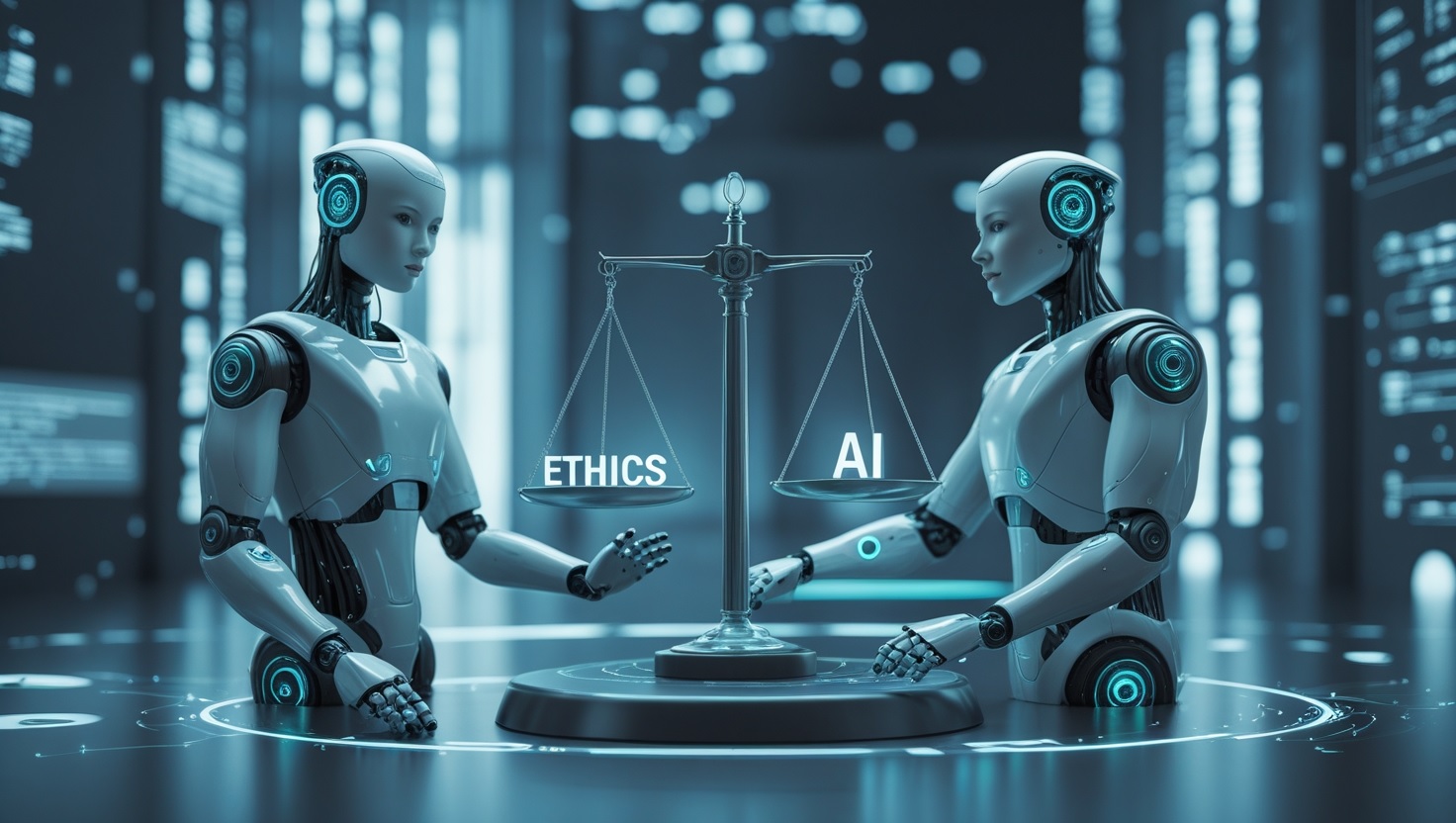Artificial intelligence (AI) has put transformative pressure on industries, from healthcare to education, reshaping how societies feature and interact. The urgency to cope with moral worries grows as AI structures increasingly affect excessive stock selections in hiring, regulation enforcement, and medical diagnostics. These technologies, whilst promising performance and innovation, also chance perpetuating historical biases, eroding privacy, and burdensome responsibility frameworks. The dual position of AI—as both a catalyst for development and a potential deliver of harm—desires rigorous moral scrutiny to ensure its improvement aligns with societal values and human rights.

- What Are Ethical Concerns in AI?
- Key Ethical Debates in AI
- Bias in AI Algorithms
- Privacy and Data Surveillance
- Accountability in AI Decisions
- The Positive Impact of AI: Ethical Benefits
- AI in Healthcare
- AI in Education and Climate Change
- The Risks and Harmful Impacts of AI
- Job Displacement
- Surveillance and Autonomy
- Proposed Solutions and Mitigating Ethical Concerns
- Ethical Frameworks and Governance
- Human-Centered AI Design
- The Future of AI Ethics
- Conclusion
- FAQs
What Are Ethical Concerns in AI?
Ethical issues in AI revolve around the accidental effects of deploying structures that lack transparency, equity, or accountability. These concerns stem from recognizing that AI is not neutral; its outputs mirror the records, assumptions, and priorities embedded during improvement 1. Key issues encompass algorithmic bias, where structures amplify societal prejudices; privacy violations, as huge information series permits surveillance; and responsibility gaps, where mistakes in AI choices lead to damage without clear obligation 3 5. For example, gender bias in seeking engine outcomes perpetuates stereotypes with the aid of prioritizing male leaders or sexualized images of women, reinforcing dangerous narratives 1. Similarly, mistaken schooling information in hiring algorithms has caused discriminatory effects, as seen in Amazon’s now-abandoned recruitment tool 2. These examples underscore the want for moral frameworks that prioritize human dignity and fairness.
Key Ethical Debates in AI
Bias in AI Algorithms
Bias in AI structures regularly originates from skewed training statistics or subjective layout selections. Machine mastering models trained on historically biased datasets and resumes predominantly from male applicants reflect and exacerbate these biases 2 3. In law enforcement, predictive policing gear risk disproportionately focused on marginalized communities if educated on racially biased arrest statistics. The undertaking lies in identifying and mitigating these biases without compromising algorithmic performance. Techniques like diverse data sampling and bias audits are essential, but their implementation remains inconsistent across industries 3.
Privacy and Data Surveillance
The ethical predicament between AI’s data starvation and individual privacy rights is intensifying. AI structures in healthcare, for example, require extensive amounts of patient facts to enhance diagnostics, but breaches or misuse may reveal sensitive facts 6. Technologies like facial recognition and predictive analytics allow mass surveillance, elevating worries about autonomy and consent 4. While facts anonymization and federated mastering provide partial answers—allowing models to teach decentralized statistics without exposing man or woman data—they can not fully put off dangers 4. Striking a balance between innovation and privacy demands sturdy regulatory frameworks and prominent information practices.
Accountability in AI Decisions
Determining accountability for AI mistakes is complex, specifically in sectors like healthcare and self-sustaining cars. Legal and moral obligations will become murky when an AI-driven diagnostic device misidentifies a tumor or self-riding automobile reasons an accident. Traditional duty fashions, which hint selections from executives to frontline people, falter when AI operates as a “black box” 5. Some suggest shared accountability, in which builders, users, and regulators endure responsibility, supported through rigorous checking out and explainable AI structures 5 6. For instance, Cedars-Sinai’s approach to AI in healthcare emphasizes validation and transparency to mitigate risks 6.
The Positive Impact of AI: Ethical Benefits

AI in Healthcare
Artificial intelligence (AI) has emerged as a modern pressure in healthcare, providing exceptional talents in disease detection, predictive analytics, and customized remedy strategies. Through advanced system mastering algorithms and neural networks, AI structures now achieve diagnostic accuracy, surpassing human professionals in specialities, from radiology to pathology 1 6. Integrating deep mastering with medical imaging has enabled early-degree cancer detection via subtle sample reputation in mammograms and CT scans, whilst predictive models and heterogeneous records streams supplied crucial insights at some point during the COVID-19 pandemic 2 7. Concurrently, homomorphic encryption addresses facts and privacy worries by enabling steady analysis of sensitive affected persons’ facts without decryption 3. However, these technological advancements necessitate sturdy ethical frameworks to mitigate algorithmic biases and ensure equitable healthcare entry. Cedars-Sinai’s operational regulations maintain human oversight and demographic validation of AI equipment 4 5. This report examines the multi-dimensional effect of AI throughout healthcare domains, reading its transformative capacity and the complicated, demanding situations requiring interdisciplinary solutions.
AI in Education and Climate Change
In training, AI-pushed customized learning structures adapt to college students’ wishes, bridging gaps in getting entry to high-quality. For weather trade, AI aids in modeling complicated environmental systems, optimizing renewable energy grids, and tracking deforestation 7. Yet, those benefits come with moral change-offs. Training large AI fashions consumes tremendous electricity, contributing to carbon emissions—a paradox that demands greener algorithms and fossil-free power resources 7.
The Risks and Harmful Impacts of AI
Job Displacement
AI-driven automation threatens to displace millions of jobs in production, retail, and transportation. While new roles may additionally emerge, the transition risks exacerbating financial inequality, especially for low-professional people 8. Ethical responses encompass reskilling packages and coverage interventions like frequent simple earnings, though their efficacy stays debated.
Surveillance and Autonomy
The proliferation of AI in surveillance technologies—from facial reputation to social media monitoring—erodes private freedoms. Autonomous gun systems, which perform without human oversight, pose existential risks; prompting requires global bans 2 8. Balancing safety and privacy requires stringent policies and public oversight to prevent misuse.
Proposed Solutions and Mitigating Ethical Concerns
Ethical Frameworks and Governance
Global standards like UNESCO’s Recommendation for the Ethics of AI emphasize transparency, fairness, and accountability 1. The EU’s AI Act imposes hefty fines for non-compliance, incentivizing moral practices 3. Multistakeholder governance, regarding governments, tech firms, and civil society, can harmonize policies while fostering innovation.
Human-Centered AI Design

Designing AI that prioritizes human values includes techniques like differential privateness, which adds noise to datasets to protect people, and participatory layout methods that include marginalized groups 4 7. IBM’s cognizance on explainable AI aims to demystify decision-making techniques, improving trust 3.
The Future of AI Ethics

As AI evolves, rising concerns encompass its environmental impact and the moral implications of fashionable-motive AI. Continuous adaptation in governance could be essential, with dynamic guidelines that hold pace with technological advances. Collaborative efforts, including AI ethics boards and move-industry partnerships, will play a pivotal role in shaping a destiny wherein AI serves humanity equitably 7 8.
Conclusion
The ethical landscape of AI is fraught with demanding situations but also ripe with possibilities. By addressing bias, safeguarding privateness, and clarifying responsibility, societies can harness AI’s capability even to mitigate harm. The course ahead requires vigilance, collaboration, and a dedication to embedding moral principles at each stage of AI development.
FAQs
What are the principal ethical concerns with AI?
Key issues include algorithmic bias, privacy violations, responsibility gaps, activity displacement, and environmental effects 1 3 7 eight.
How can bias in AI be reduced?
Strategies encompass diversifying training statistics, carrying out bias audits, and related to multidisciplinary groups in AI design 1 3.
What role do governments need to play in regulating AI?
Governments must establish enforceable requirements, fund impartial audits, and sell worldwide cooperation to save you regulatory arbitrage 3 5 7.
How can AI benefit society without compromising ethics?
Prioritizing human-focused layout, transparency, and equitable right of entry guarantees AI aligns with societal values whilst using innovation 4 6.
Is AI law necessary for destiny?
Yes. Regulation safeguards against misuse, ensure duty, and fosters public belief in AI structures 3 5 7.


